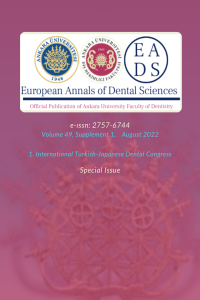Abstract
Aim All permanent teeth can remain impacted. Impacted teeth can remain in the jaw for years without showing any symptoms and causing a pathological event, and they can also cause neuralgiform pain, infection, teinporomandibular joint complaints, root resorption in neighboring teeth, and pathologies. Pericoronal radiolucency observed over 2.5 mm in radiographic imaging is suspicious. The aim of this study is to investigate the frequency of pericoronal radiolucency in impacted teeth examined on panoramic radiographs.
Methods The study was conducted by retrospectively examining panoramic radiographs of 1128 patients (633 females, 495 males) over the age of 18. Permanent impacted teeth with complete root development were included in the study, and primary teeth, mesiodens, supernumerary and supplemental impacted teeth were excluded from the study. Pericoronal radiolucency was recorded as 'present' in case of pericoronal radiolucency (>3 mm) associated with impacted permanent tooth on panoramic radiographs. SPSS v.21 (IBM Corp., Armonk, NY, USA) program was used to analyze the data.
Results The mean age of the individuals included in the study was 31±11 years (18-85). A total of 2247 impacted teeth from 1128 individuals were evaluated. Pericoronal radiolucency was detected in 208 impacted teeth (9.3%). There was a statistically significant relationship between gender and the frequency of pericoronal radiolucency (p<0.05). The frequency of pericoronal radiolucency is lower in females and individuals over 60 years of age.
Conclusion The frequency of pericoronal radiolucency associated with impacted teeth is 9.3%. This condition is more likely to be seen on radiographic examinations in males and individuals under 60 years of age. It is recommended that teeth that have erupted but are not located in the arch in clinical examination should be carefully examined radiologically in order to detect them at an early pathological stage and to make appropriate treatment.
References
- 1. Rajic S, Muretic Z, Percac S: Impacted canine in a prehistoric skull. Angle Orthod 1996;66(6):477-80.
- 2. Dural S, Avcı N, Karabıyıkoğlu T: Gömük dişlerin görülme sıklığı, çenelere göre dağılımları ve gömülü kalma nedenleri. Atatürk Üniv Diş Hek Fak Derg 1996;7(16):127-33.
- 3. Mortazavi H, Baharvand M: Jaw lesions associated with impacted tooth: A radiographic diagnostic guide. Imaging Sci Dent 2016;46(3):147.
- 4. Mortazavi H, Baharvand M, Rahmani S, Jafari S, Parvaei P: Radiolucent rim as a possible diagnostic aid for differentiating jaw lesions. Imaging Sci Dent 2015;45(4):253.
- 5. Villalba L, Stolbizer F, Blasco F, Mauriño NR, Piloni MJ, Keszler A: Pericoronal follicles of asymptomatic impacted teeth: a radiographic, histomorphologic, and immunohistochemical study. Int J Dent 2012;2012.
- 6. Gisakis IG, Palamidakis FD, Farmakis ETR, Kamberos G, Kamberos S, Dentistry C: Prevalence of impacted teeth in a Greek population. J Investig Clin Dent 2011;2(2):102-9.
- 7. Kotrashetti VS, Kale AD, Bhalaerao SS, Hallikeremath S: Histopathologic changes in soft tissue associated with radiographically normal impacted third molars. Indian J Dent Res 2010;21(3):385.
- 8. Edamatsu M, Kumamoto H, Ooya K, Echigo S, Oral Medicine, Oral Pathology, Oral Radiology, Endodontology. Apoptosis-related factors in the epithelial components of dental follicles and dentigerous cysts associated with impacted third molars of the mandible. Oral Surg Oral Med Oral Pathol Oral Radiol Endod 2005;99(1):17-23.
- 9. Glosser J, Campbell J, Surgery M: Pathologic change in soft tissues associated with radiographically ‘normal’third molar impactions. Br J Oral Maxillofac Surg 1999;37(4):259-60.
- 10. Gomes VR, Melo MCS, Carnei HC, Pinho JET, Teixeira M: Hyperplastic dental follicle: case report. J Bras Patol Med Lab 2019;55:315-20.
Abstract
References
- 1. Rajic S, Muretic Z, Percac S: Impacted canine in a prehistoric skull. Angle Orthod 1996;66(6):477-80.
- 2. Dural S, Avcı N, Karabıyıkoğlu T: Gömük dişlerin görülme sıklığı, çenelere göre dağılımları ve gömülü kalma nedenleri. Atatürk Üniv Diş Hek Fak Derg 1996;7(16):127-33.
- 3. Mortazavi H, Baharvand M: Jaw lesions associated with impacted tooth: A radiographic diagnostic guide. Imaging Sci Dent 2016;46(3):147.
- 4. Mortazavi H, Baharvand M, Rahmani S, Jafari S, Parvaei P: Radiolucent rim as a possible diagnostic aid for differentiating jaw lesions. Imaging Sci Dent 2015;45(4):253.
- 5. Villalba L, Stolbizer F, Blasco F, Mauriño NR, Piloni MJ, Keszler A: Pericoronal follicles of asymptomatic impacted teeth: a radiographic, histomorphologic, and immunohistochemical study. Int J Dent 2012;2012.
- 6. Gisakis IG, Palamidakis FD, Farmakis ETR, Kamberos G, Kamberos S, Dentistry C: Prevalence of impacted teeth in a Greek population. J Investig Clin Dent 2011;2(2):102-9.
- 7. Kotrashetti VS, Kale AD, Bhalaerao SS, Hallikeremath S: Histopathologic changes in soft tissue associated with radiographically normal impacted third molars. Indian J Dent Res 2010;21(3):385.
- 8. Edamatsu M, Kumamoto H, Ooya K, Echigo S, Oral Medicine, Oral Pathology, Oral Radiology, Endodontology. Apoptosis-related factors in the epithelial components of dental follicles and dentigerous cysts associated with impacted third molars of the mandible. Oral Surg Oral Med Oral Pathol Oral Radiol Endod 2005;99(1):17-23.
- 9. Glosser J, Campbell J, Surgery M: Pathologic change in soft tissues associated with radiographically ‘normal’third molar impactions. Br J Oral Maxillofac Surg 1999;37(4):259-60.
- 10. Gomes VR, Melo MCS, Carnei HC, Pinho JET, Teixeira M: Hyperplastic dental follicle: case report. J Bras Patol Med Lab 2019;55:315-20.
Details
| Primary Language | English |
|---|---|
| Subjects | Dentistry |
| Journal Section | Conference Papers |
| Authors | |
| Publication Date | August 31, 2022 |
| Submission Date | November 4, 2021 |
| Published in Issue | Year 2022 Volume: 49 Issue: Suppl 1 |

